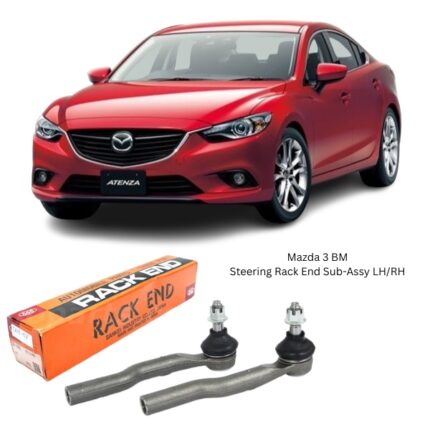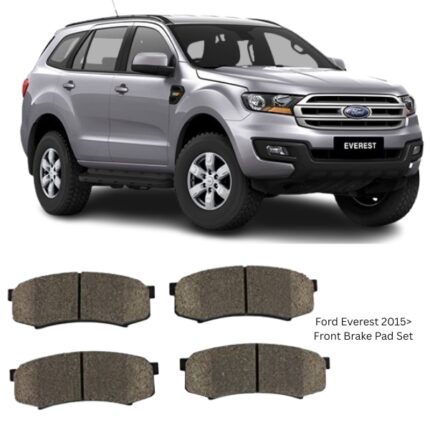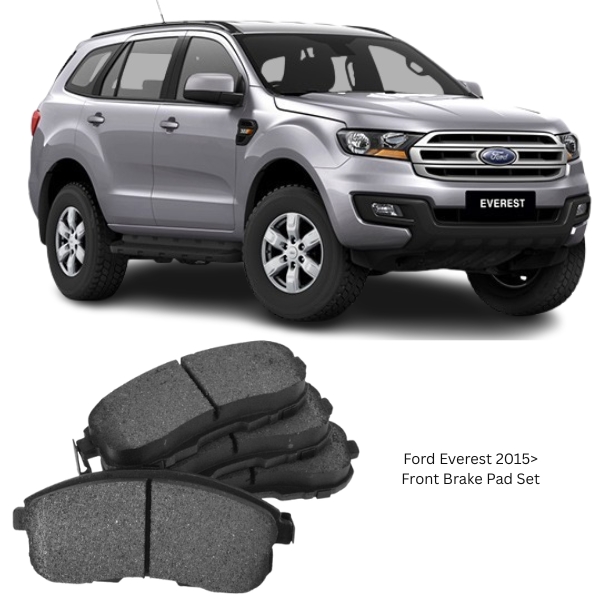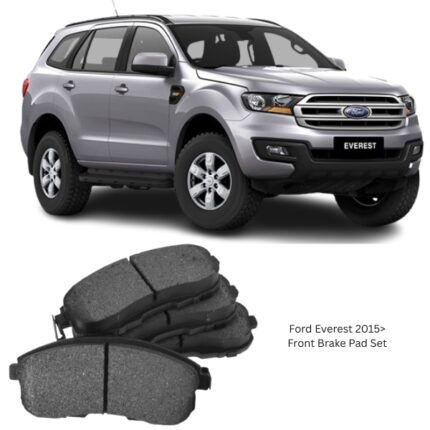Get Ford Everest Rear Brake Pad Set D20182 in Kenya
The rear brake pad set is a vital component within a vehicle’s braking system, responsible for delivering controlled, reliable deceleration and stopping power. Operating within the rear disc brake assembly, these pads work by applying friction to the brake rotor (disc) when the brake pedal is pressed. This friction is what slows the rotation of the wheels and ultimately brings the vehicle to a halt.
Construction and Material Composition
Brake pads are composed of several layers and materials specifically designed to balance performance, safety, and durability. The key parts include:
-
Friction Material: This is the layer that comes into contact with the brake disc. It’s made from specially engineered composites designed to withstand high temperatures and provide consistent stopping power. Common materials include ceramic, semi-metallic, and organic compounds.
-
Steel Backing Plate: This rigid plate supports the friction material, ensuring it remains securely positioned against the caliper piston and disc.
-
Shim and Insulation Layers: These layers help reduce vibrations and noise during braking. They also provide some thermal insulation to protect other braking components from heat transfer.
Modern rear brake pads are typically formulated to produce minimal dust and noise while maximizing durability and performance. They also incorporate wear indicators—either mechanical or electronic—that signal when replacement is due.
Functionality and Operation
When the brake pedal is pressed, hydraulic pressure forces the caliper pistons to push the brake pads against the rotating disc. This contact converts kinetic energy into thermal energy through friction, causing the vehicle to slow down or stop.
Rear brake pads tend to wear slower than their front counterparts since the front brakes bear more of the stopping force. However, maintaining rear brake pad integrity is crucial for overall brake balance, stability, and parking brake functionality—especially in systems where the parking brake is integrated into the rear disc setup.
Key Features
-
High Friction Stability: The pads are engineered to maintain consistent friction levels, even under varying temperature and load conditions.
-
Thermal Resistance: Able to withstand extreme temperatures generated during repeated braking.
-
Low Noise and Vibration: Designed with chamfers, slots, and shims to reduce brake noise and prevent juddering.
-
Dust Minimization: Formulated to produce minimal brake dust, preserving wheel cleanliness and reducing wear.
-
Corrosion Resistance: Coated or treated backing plates and shims to withstand moisture and environmental contaminants.
Installation and Fitment
Replacing rear brake pads requires access to the vehicle’s rear wheels, brake calipers, and sometimes the parking brake system. The general installation process includes:
-
Lifting the Vehicle: The rear wheels are removed for access to the brake components.
-
Removing the Caliper: The caliper bolts are loosened or removed, and the caliper is slid away from the disc.
-
Removing Old Pads: The worn pads are taken out of their slots.
-
Inspecting Components: It’s common practice to inspect the rotor, caliper piston, and caliper guide pins for wear or damage.
-
Installing New Pads: The new pads are slotted in, sometimes with a thin layer of anti-seize compound or brake grease applied to contact points to prevent noise.
-
Reassembly and Testing: The caliper is reinstalled, bolts torqued, and the system is tested after reassembly. The brake pedal may need to be pumped to restore pressure.
Note: Some modern vehicles may require an electronic retraction tool or a diagnostic tool to reset the electronic parking brake system when replacing rear pads.
Maintenance and Lifespan
Rear brake pads typically last longer than front pads, but their lifespan is influenced by:
-
Driving Habits: Aggressive braking, frequent towing, or heavy loads accelerate wear.
-
Environment: Hilly terrain or urban stop-and-go traffic results in quicker wear.
-
Material Quality: Higher-quality pads generally last longer and perform more consistently.
Common signs that rear brake pads require replacement include:
-
Squealing or grinding noises when braking
-
Reduced braking performance or longer stopping distances
-
Vibrations during braking
-
Warning lights on the dashboard (for systems with wear sensors)
-
Visible wear on the pads (thickness below 3mm)
It’s advisable to inspect brake pads at regular service intervals and replace them in pairs to maintain braking balance across both rear wheels.
Advantages of a New Rear Brake Pad Set
-
Improved Braking Efficiency: Fresh pads restore optimal stopping performance, especially under emergency braking.
-
Enhanced Safety: Reliable rear braking contributes to overall vehicle stability, particularly during sharp turns or sudden stops.
-
Reduced Brake Fade: New pads offer better resistance to heat-induced fading.
-
Quieter Operation: Replacing worn or uneven pads can eliminate squeals or groans.
-
Extended Component Life: Timely replacement prevents damage to brake discs and calipers.
Safety Considerations
Working with braking systems requires care and precision. Poor installation or neglecting to replace worn pads can result in:
-
Reduced brake effectiveness
-
Rotor damage due to metal-on-metal contact
-
Brake fluid leaks from overextended caliper pistons
-
Compromised handling or stability
-
Increased risk of accidents, particularly in wet or steep conditions
Always ensure proper torque specifications are followed when reinstalling calipers and that the braking system is tested thoroughly before driving.
Environmental Considerations
Some modern brake pads are manufactured using eco-friendly, non-toxic materials. These pads meet international standards for reducing copper and heavy metal content, which are harmful to the environment when released as dust or waste.
Proper disposal of old brake pads is also essential. Many regions offer recycling programs for used friction materials to prevent environmental contamination.
Follow us on Facebook for more parts.





Reviews
Clear filtersThere are no reviews yet.